Archimedes' Principle: Why Ships Float But Rocks Sink
The 2,000-Year-Old Bath Discovery That Changed Everything
This is The Curious Mind, by Álvaro Muñiz: a newsletter where you will learn about technical topics in an easy way, from decision-making to personal finance.
Have you ever wondered why heavy cargo ships float, yet a tiny 1kg rock sinks deep into the ocean? Why does an underwater air bubble rise up towards the surface, instead of staying still or sinking further down? Why do we humans float in the ocean?
The famous Greek mathematician, physicist, and inventor Archimedes of Syracuse wondered about the same questions while taking a bath over 2,000 years ago. What he discovered is one of the most important laws of fluid mechanics—and it is much simpler than you think.
Archimedes’ Take on Buoyancy
Archimedes’ principle is one of those physical laws that, despite being very simple, has far-reaching applications. In his treaty On Floating Bodies, the great Archimedes proposed the following principle:
Any object, totally or partially immersed in a fluid, is buoyed up by a force equal to the weight of the fluid displaced by the object.
Let’s unpack what this actually means.
When Things Go Down
As shown in the figure, suppose we have a 5kg piece of iron (left). We submerge it into a tank full of water, which causes some of the water to be displaced—in our case, 2kg of water (right). Archimedes’ principle says that the iron piece will be buoyed up by a force equal to those 2kg. So, after submerging the iron piece:
Its weight of 5kg pulls it down.
The buoyant force pulls it up with a force of 2kg.
Overall, there is a downward pull of 3kg (see scale on right).
In this case, the iron piece still has a net downward force after submerging it, so it will sink down.
When Things Rise Up
Now here comes the key insight:
The amount of water that is displaced depends on the size of the object, not on its weight.
Why is this game-changing?
Suppose that, instead of having a 5kg piece of iron, we have a 5kg piece of wood. Wood is way less dense than iron (it’s less 'compact'), which means that 5kg of wood occupies a much larger volume than 5kg of iron. If we crunch the numbers, we can find that it will displace something like 10kg of water (depending on the type of wood).
So, what happens?
The wood’s weight of 5kg pulls it down.
The buoyant force pulls it up with a force equal to the water it displaces, i.e., 10kg (Archimedes’ principle).
Overall, there is an upward pull of 5kg.
Since the net force points upward, the wood piece will float up towards the surface.
The Basketball Experiment You Can Try Today
This upward pull is a common phenomenon in real-life.
Have you ever tried fully submerging a basketball into the ocean? You can certainly do it, but you will feel how it pushes up towards the surface. In fact, in this extreme case it does it so strongly that it will jump high into the air if you release it!
As shown in the image, if you instead leave the basketball on the surface of the water, you’ll find that it’s only partially submerged: most of it is above the surface, while a small portion is submerged below the surface.
Archimedes’ principle explains this. For the ball to be in equilibrium—neither sinking down nor going up, just floating steadily—the downward pull must be exactly equal to the upward pull.
The downward pull is constant and equal to the weight of the ball.
The upward pull depends on the amount of water displaced (Archimedes’ principle).
Physics tells us that the ball will submerge precisely enough so that the amount of water it displaces is exactly equal to its own weight.
This is why a cork is nearly fully above water when floating (it needs to displace very little water), yet a piece of wood might be half-submerged.
Why Do Massive Ships Float?
Cargo ships are mind-bogglingly heavy.
They are not only made of heavy steel, but also carry massive amounts of equipment, containers, people, food, fuel and water. The largest bulk carriers can weigh up to 500,000,000 kg (that’s roughly 100,000 elephants!).
How can these floating giants stay afloat?
Archimedes’ principle gives the answer: by displacing an enormous amount of water.
If you looked underwater, you’d discover that a ship has a considerable portion of its total size submerged under water. It’s 'partially submerged', as we discussed above. The amount of water it displaces is precisely enough to keep itself floating.
When cargo ships are designed, engineers estimate their maximum weight as the sum of the weights of the cargo, hull, fittings, equipment, propelling and auxiliary machinery, piping systems, electrical and electronic gear, fuel, water, consumable stores, passengers and crew (plus a margin of a few percent for weights that are underestimated).1 They then design the shape of the ship such that, given this total maximum weight, the ship is big enough to displace enough water to float.
Thanks to a mathematician's bathtub eureka moment 2,000 years ago, we now have container ships carrying your Amazon packages across the Pacific!
My Scuba Diving Adventure (and How Physics Saved the Day)
I’ve just come back from a trip in Southeast Asia where I learned to scuba dive. In fact, it was this experience that motivated me to write this post.
Scuba divers use weight belts (usually made of lead pieces) to sink underwater. When they reach the desired depth for the dive—that is, they don’t want to sink down any further, nor rise up towards the surface—they use Archimedes’ principle:
By inflating their BCD (buoyancy control device, a vest that can be inflated) with just the right amount of air such that the volume of water this air displaces is equal to the weight of the scuba diver plus their weight belt, they achieve neutral buoyancy and hover motionless underwater.
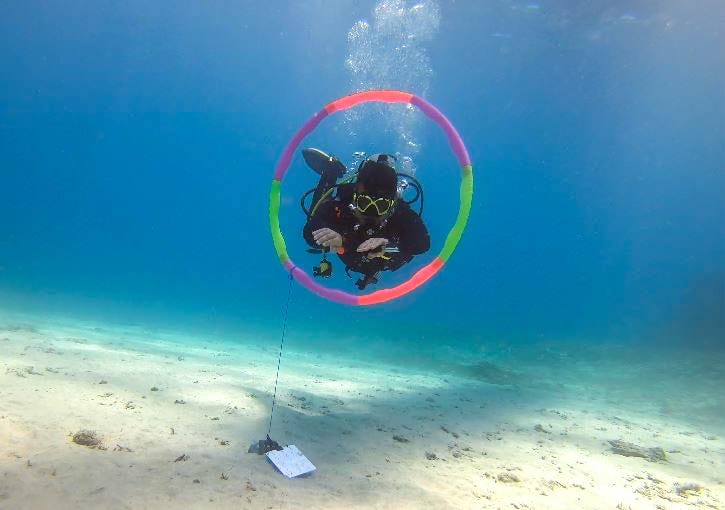
If a scuba diver wants to ascend slightly to avoid a rock, or descend to examine something closer, they could inflate or deflate their BCD to achieve it.
But here’s the really cool part!
In reality, scuba divers use their own lungs to move up and down once they have reached neutral buoyancy. Our lungs expand and contract as we breathe, thus displacing more or less water. By adjusting their breathing patterns—taking deeper breaths if they want to rise up, or exhaling more fully if they want to sink down—scuba divers can rise and sink as they wish.
Try This Yourself
Next time you go swimming, try it yourself! If you are floating in the water and take a deep breath, what do you think you will feel?
This is Archimedes’ principle in action, powered by your own lungs!
More Amazing Applications of Archimedes’ Principle
Hot Air Balloons: the heated air inside is less dense than the cool air outside, so the balloon displaces more weight in air than it actually weighs—up it goes!
Submarines: They control their buoyancy by flooding or emptying ballast tanks with water, changing how much water they displace.
Ice Floating: Ever wonder why icebergs are mostly underwater? Ice is less dense than water, but only slightly—so about 90% stays submerged while 10% peeks above the surface.
Hydrometers: These devices measure liquid density by seeing how deep they sink—the denser the liquid, the higher they float!
In Case You Missed It
What do You Want Next?
From Encyclopedia Britannica.



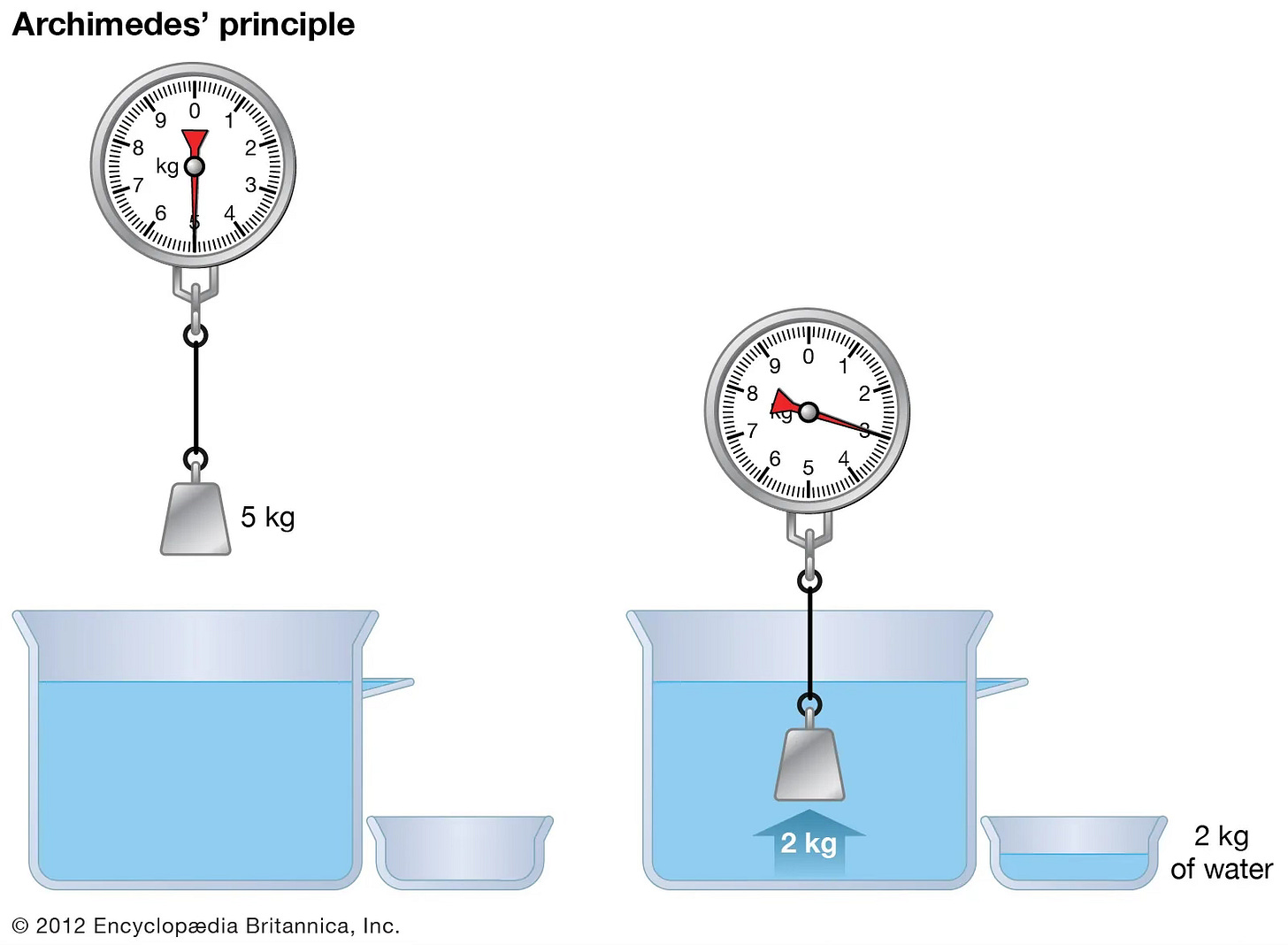
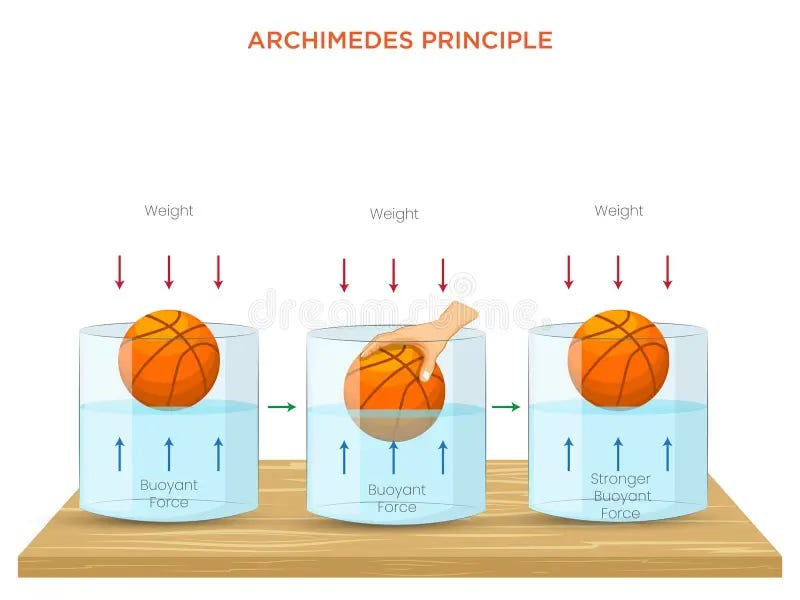
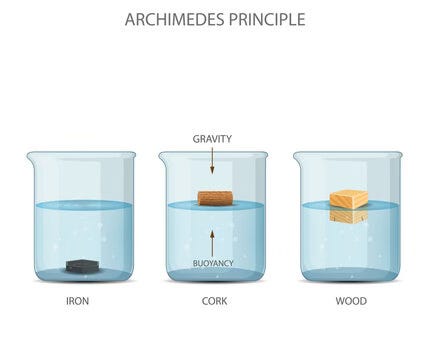
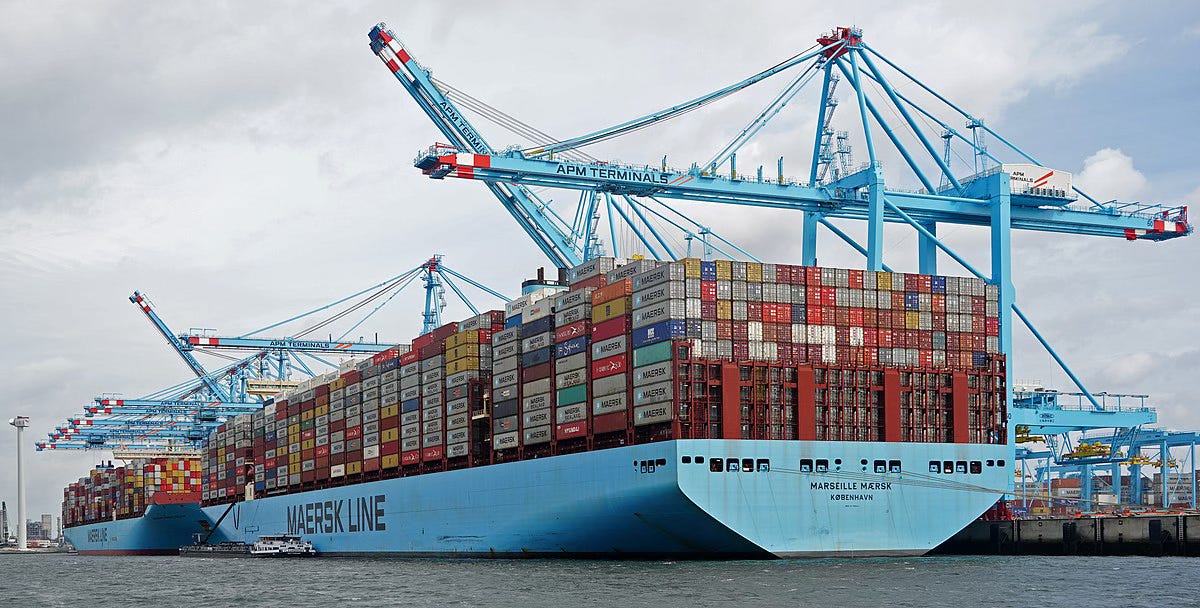




Great explanation!! It was also cool to see how many uses this has!